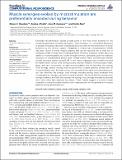Muscle synergies evoked by microstimulation are preferentially encoded during behavior
Author(s)
Overduin, Simon A.; d'Avella, Andrea; Carmena, Jose M.; Bizzi, Emilio
DownloadBizzi_Muscle Synergies.pdf (809.6Kb)
PUBLISHER_POLICY
Publisher Policy
Article is made available in accordance with the publisher's policy and may be subject to US copyright law. Please refer to the publisher's site for terms of use.
Terms of use
Metadata
Show full item recordAbstract
Electrical microstimulation studies provide some of the most direct evidence for the neural representation of muscle synergies. These synergies, i.e., coordinated activations of groups of muscles, have been proposed as building blocks for the construction of motor behaviors by the nervous system. Intraspinal or intracortical microstimulation (ICMS) has been shown to evoke muscle patterns that can be resolved into a small set of synergies similar to those seen in natural behavior. However, questions remain about the validity of microstimulation as a probe of neural function, particularly given the relatively long trains of supratheshold stimuli used in these studies. Here, we examined whether muscle synergies evoked during ICMS in two rhesus macaques were similarly encoded by nearby motor cortical units during a purely voluntary behavior involving object reach, grasp, and carry movements. At each microstimulation site we identified the synergy most strongly evoked among those extracted from muscle patterns evoked over all microstimulation sites. For each cortical unit recorded at the same microstimulation site, we then identified the synergy most strongly encoded among those extracted from muscle patterns recorded during the voluntary behavior. We found that the synergy most strongly evoked at an ICMS site matched the synergy most strongly encoded by proximal units more often than expected by chance. These results suggest a common neural substrate for microstimulation-evoked motor responses and for the generation of muscle patterns during natural behaviors.
Date issued
2014-03Department
Massachusetts Institute of Technology. Department of Brain and Cognitive Sciences; McGovern Institute for Brain Research at MITJournal
Frontiers in Computational Neuroscience
Publisher
Frontiers Research Foundation
Citation
Overduin, Simon A., Andrea d’ Avella, Jose M. Carmena, and Emilio Bizzi. “Muscle Synergies Evoked by Microstimulation Are Preferentially Encoded During Behavior.” Frontiers in Computational Neuroscience 8 (March 5, 2014).
Version: Final published version
ISSN
1662-5188